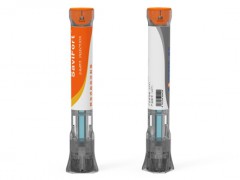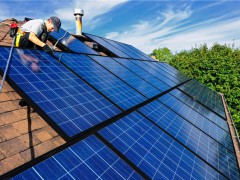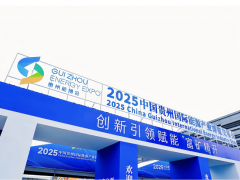???? 據(jù)油氣新聞2月8日消息稱,能源世界正在發(fā)生變化,而且變化的速度比大多數(shù)專家一年前預(yù)測(cè)的還要快。即使在大流行期間,可再生能源技術(shù)的應(yīng)用也在加速發(fā)展,碳捕集與封存(CCS)、電池存儲(chǔ)和氫氣這三個(gè)競(jìng)爭(zhēng)者已開(kāi)始進(jìn)行競(jìng)爭(zhēng),以減少排放,并幫助越來(lái)越多正在制定凈零目標(biāo)的國(guó)家、行業(yè)和公司。
????為了解決能源轉(zhuǎn)型并確定最新趨勢(shì),雷斯塔能源自豪地出版了每月的《能源轉(zhuǎn)型報(bào)告》,該報(bào)告展示并分析了關(guān)鍵轉(zhuǎn)型變量、社會(huì)和技術(shù)的最新發(fā)展。
????我們的評(píng)估表明,CCS作為一項(xiàng)技術(shù),理論上有潛力解決全球62%(250億噸)的二氧化碳排放,但是,考慮到傳統(tǒng)CCS的捕獲率高達(dá)90%左右,像直接空氣捕捉(DAC)和生物能源CCS (BECCS)這樣的凈負(fù)技術(shù)將是需要的。然而,CCS不太可能達(dá)到這一水平。
????目前的CCS項(xiàng)目組合每年捕獲約40兆噸碳。如果我們將即將到來(lái)的項(xiàng)目管道計(jì)算在內(nèi),到2026年底,這個(gè)數(shù)字將增加到每年110兆噸。
????這些數(shù)字與IEA的可持續(xù)發(fā)展設(shè)想相比較,2050年將捕獲56億噸天然氣,比目前的管道儲(chǔ)量增加50倍。要占領(lǐng)整個(gè)潛在市場(chǎng),需要在IEA SDS方案的基礎(chǔ)上再增加4倍。
????雷斯塔能源公司高級(jí)副總裁兼全球能源系統(tǒng)主管Marius Foss說(shuō)“我們最終將在很大程度上依賴于碳價(jià)格的發(fā)展,目前的碳價(jià)格遠(yuǎn)遠(yuǎn)低于支持大多數(shù)CCS應(yīng)用所需的水平歐洲一些國(guó)家和美國(guó)的一些州可能是例外,它們利用排放交易系統(tǒng)(ETS)、碳排放稅、碳排放信用或更直接的補(bǔ)貼計(jì)劃。”
????就溫室氣體排放總量而言,CCS理論上可以解決全球48%的溫室氣體排放,這是對(duì)我們上次發(fā)布的一般能源轉(zhuǎn)型報(bào)告的向上修訂,該報(bào)告增加了一些工業(yè)溫室氣體排放。
????曹海斌 摘譯自 油氣新聞
????原文如下:
????CCS could tap 62% of world’s CO2 emissions: Rystad Energy
????The energy world is changing, and quicker than most experts predicted only a year ago. The adaptation of renewable energy technologies is accelerating, even during the pandemic, and three contenders – carbon capture and storage (CCS), battery storage and hydrogen – have begun a competitive race to reduce emissions and assist the increasing number of countries, industries and companies that are setting net zero targets.
????To address the energy transition and identify the latest trends, Rystad Energy has proudly initiated a monthly Energy Transition Report, which showcases and analyzes the latest developments across key transition variables, societies and technologies.
????Our assessment shows that CCS as a technology has the theoretical potential to address 62% (25 gigatonnes, GT) of global CO2 emissions, but net-negative technologies such as Direct Air Capture (DAC) and Bio Energy CCS (BECCS) will be needed given that traditional CCS has a capture rate of up to approximately 90%. However, it is unlikely that CCS will ever reach this level.
????The current portfolio of operational CCS projects captures roughly 40 megatonnes (Mt) per year; if we include the upcoming project pipeline, this number increases to 110 Mt per year for projects that are to come online by the end of 2026.
????These numbers compare to the IEA’s Sustainable Development Scenario, with 5.6 Gt captured in 2050, representing a 50x increase from the current pipeline. To capture the total addressable market would require an additional 4x increase above the IEA SDS scenario.
????“Where we end up will rely heavily on the development in carbon prices, which today are far below the levels needed to support most applications of CCS. The exceptions are perhaps in some European countries and some states in the US, which utilize a combination of emissions trading systems (ETS), carbon tax, carbon credits, or more direct subsidy schemes,” says Marius Foss, senior vice president and head of global energy systems at Rystad Energy.
????When it comes to total greenhouse gas emissions (GHG), CCS could theoretically address up to 48% of the world’s total, an upwards revision of our last general energy transition report that adds some more industrial GHG emissions.







